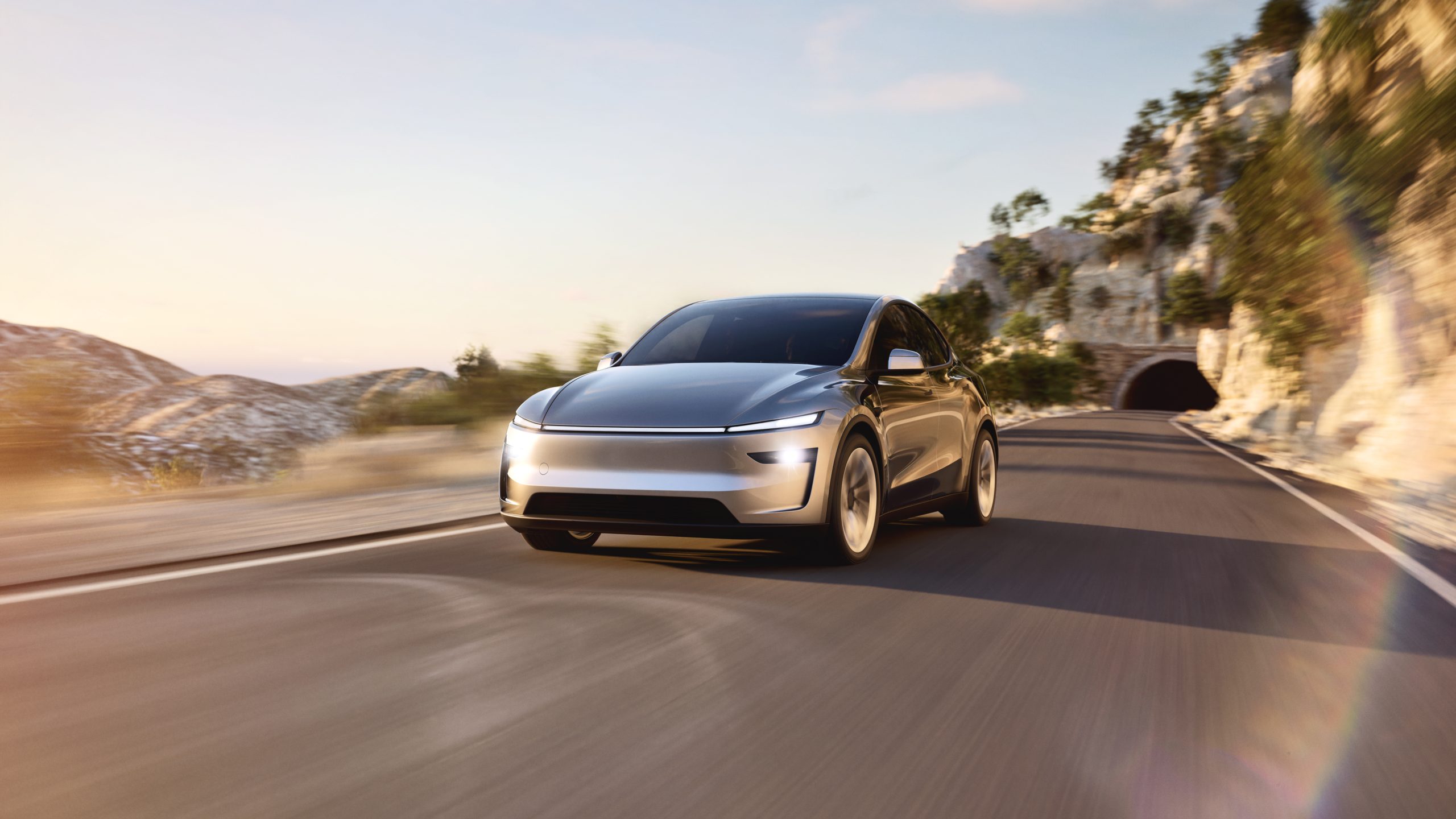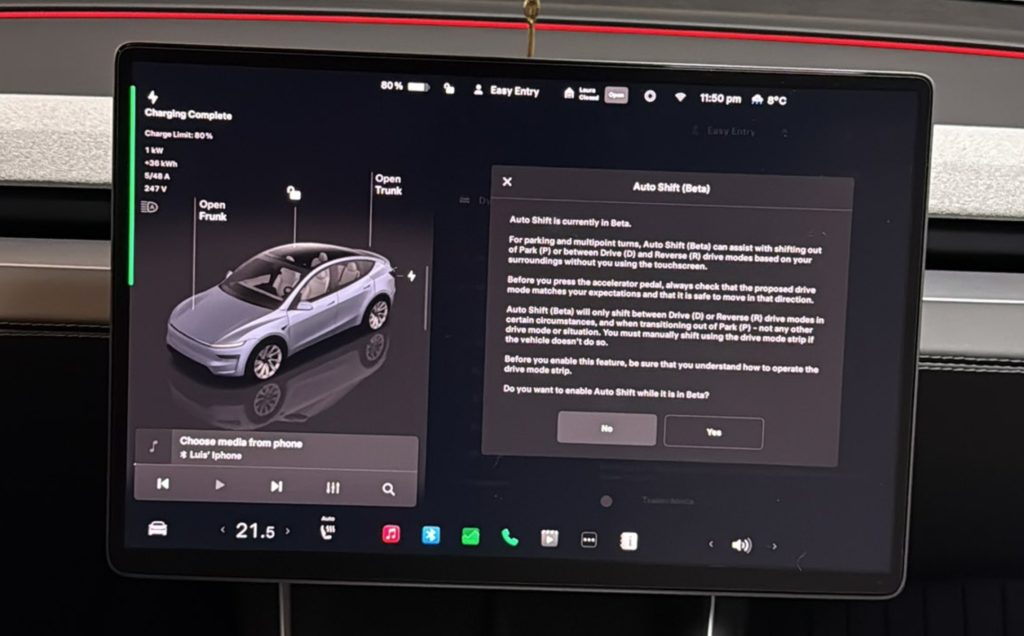News
Tesla’s new Model Y gets first software update—Here’s what’s in it
Tesla’s new Model Y started delivering over the past few weeks, and its first software update is now here.

Tesla has officially started deploying its first software update for the recently refreshed Model Y, and it appears to add additional parts of a beta version of the Auto Shift feature, as highlighted by one owner this week.
After Tesla began deploying its software update 2025.8.6 over the past few days, photos from a couple of owners show that the refreshed Model Y has also started receiving the update. One Model Y owner, X user LRESP, posted on Sunday that the update also enables the latest version of Tesla’s beta Auto-Shift feature, as was echoed by another user in the thread.
Although some have pointed out that the new Model Y already had Auto-Shift enabled, the user points out that this update includes the version of the feature that allows three-point turns, though previous versions only allowed it to get out of park.
You can see the message displayed on the Model Y owner’s vehicle below, along with a few other notes about the recent software update.
Tesla’s Auto Shift (Beta) on Model Y
Auto Shift is currently in Beta.
For parking and multipoint turns, Auto Shift (Beta) can assist with shifting out of Park (P) or between Drive (D) and Reverse (R) drive modes based on your surroundings without you using the touchscreen.
Before you press the accelerator pedal, always check that the proposed drive mode matches your expectations and that it is safe to move in that direction.
Auto Shift (Beta) will only shift between Drive (D) or Reverse (R) drive modes in certain circumstances, and when transitioning out of Park (P) – not any other drive mode or situation. You must manually shift using the drive mode strip if the vehicle doesn’t do so.
Before you enable this feature, be sure that you understand how to operate the drive mode strip.
Do you want to enable Auto Shift while it is in Beta?
[No][Yes]

Credit: RE_LuisEV | X
Auto Shift between D & R is arguably one of the most underrated features of Tesla’s vehicles.
It’s something that has to be experienced to be fully appreciated. But once experienced, it’s pretty difficult to go back.pic.twitter.com/m60nDslbhy
— TESLARATI (@Teslarati) March 13, 2025
READ MORE ON TESLA MODEL Y: Tesla redesigned this crucial piece of hardware on the new Model Y
Tesla’s software update 2025.8.6
Along with Auto-Shift, Tesla has also added a number of other features with software update 2025.8.6, as shared a few days ago by Not a Tesla App. The update is also going out to legacy vehicles and Cybertrucks, and while the Auto-Shift beta addition is the only feature exclusively going out to the new Model Y, a handful of minor improvements are going out to most or all of Tesla’s lineup.
These include the ability to view the last 10, 100, or 200 miles of energy usage in the Consumption page, and the ability to clear your energy history. Tesla also notes that the battery’s energy estimates now account for all vehicle usage characteristics, along with being adjusted over time based on your driving history.
The update also lets owners run a Battery Health Test, which measures battery energy retention since the vehicle was new. This option can be found in the Controls, Service, and Battery Health menus.
Select Model Y units with model years between 2022 and 2024 have now been updated to use the cabin radar, a feature which is now being deployed standard with the refreshed version of the SUV.
The update also includes security fixes and other improvements that aren’t specifically documented, which went out to the company’s entire lineup.
These include some improvements to voice guidance and spoken directions, including that they automatically and immediately stop when ending a trip, rather than finishing phrases that have already started being spoken.
Additionally, Tesla improved the rainbow road feature in the update, no longer overlaying the visual overtop of the blue Autopilot visualization as it did in past updates. It also still incorporates certain Autopilot features, such as the display of arrows when the vehicle suddenly slows down.
For the Cybertruck, the update adds steer-by-wire improvements and the ability to adjust air suspension ride height using the Tesla mobile app. Meanwhile, the update also makes it so that Model 3 vehicles automatically transition to Standard Ride & Handling when Autopilot is engaged, though it can be disabled by navigating to Controls, Dynamics, and Use Standard Ride & Handling in Autopilot within the menus.

Elon Musk
Starlink passes 9 million active customers just weeks after hitting 8 million
The milestone highlights the accelerating growth of Starlink, which has now been adding over 20,000 new users per day.

SpaceX’s Starlink satellite internet service has continued its rapid global expansion, surpassing 9 million active customers just weeks after crossing the 8 million mark.
The milestone highlights the accelerating growth of Starlink, which has now been adding over 20,000 new users per day.
9 million customers
In a post on X, SpaceX stated that Starlink now serves over 9 million active users across 155 countries, territories, and markets. The company reached 8 million customers in early November, meaning it added roughly 1 million subscribers in under seven weeks, or about 21,275 new users on average per day.
“Starlink is connecting more than 9M active customers with high-speed internet across 155 countries, territories, and many other markets,” Starlink wrote in a post on its official X account. SpaceX President Gwynne Shotwell also celebrated the milestone on X. “A huge thank you to all of our customers and congrats to the Starlink team for such an incredible product,” she wrote.
That growth rate reflects both rising demand for broadband in underserved regions and Starlink’s expanding satellite constellation, which now includes more than 9,000 low-Earth-orbit satellites designed to deliver high-speed, low-latency internet worldwide.
Starlink’s momentum
Starlink’s momentum has been building up. SpaceX reported 4.6 million Starlink customers in December 2024, followed by 7 million by August 2025, and 8 million customers in November. Independent data also suggests Starlink usage is rising sharply, with Cloudflare reporting that global web traffic from Starlink users more than doubled in 2025, as noted in an Insider report.
Starlink’s momentum is increasingly tied to SpaceX’s broader financial outlook. Elon Musk has said the satellite network is “by far” the company’s largest revenue driver, and reports suggest SpaceX may be positioning itself for an initial public offering as soon as next year, with valuations estimated as high as $1.5 trillion. Musk has also suggested in the past that Starlink could have its own IPO in the future.
News
NVIDIA Director of Robotics: Tesla FSD v14 is the first AI to pass the “Physical Turing Test”
After testing FSD v14, Fan stated that his experience with FSD felt magical at first, but it soon started to feel like a routine.

NVIDIA Director of Robotics Jim Fan has praised Tesla’s Full Self-Driving (Supervised) v14 as the first AI to pass what he described as a “Physical Turing Test.”
After testing FSD v14, Fan stated that his experience with FSD felt magical at first, but it soon started to feel like a routine. And just like smartphones today, removing it now would “actively hurt.”
Jim Fan’s hands-on FSD v14 impressions
Fan, a leading researcher in embodied AI who is currently solving Physical AI at NVIDIA and spearheading the company’s Project GR00T initiative, noted that he actually was late to the Tesla game. He was, however, one of the first to try out FSD v14.
“I was very late to own a Tesla but among the earliest to try out FSD v14. It’s perhaps the first time I experience an AI that passes the Physical Turing Test: after a long day at work, you press a button, lay back, and couldn’t tell if a neural net or a human drove you home,” Fan wrote in a post on X.
Fan added: “Despite knowing exactly how robot learning works, I still find it magical watching the steering wheel turn by itself. First it feels surreal, next it becomes routine. Then, like the smartphone, taking it away actively hurts. This is how humanity gets rewired and glued to god-like technologies.”
The Physical Turing Test
The original Turing Test was conceived by Alan Turing in 1950, and it was aimed at determining if a machine could exhibit behavior that is equivalent to or indistinguishable from a human. By focusing on text-based conversations, the original Turing Test set a high bar for natural language processing and machine learning.
This test has been passed by today’s large language models. However, the capability to converse in a humanlike manner is a completely different challenge from performing real-world problem-solving or physical interactions. Thus, Fan introduced the Physical Turing Test, which challenges AI systems to demonstrate intelligence through physical actions.
Based on Fan’s comments, Tesla has demonstrated these intelligent physical actions with FSD v14. Elon Musk agreed with the NVIDIA executive, stating in a post on X that with FSD v14, “you can sense the sentience maturing.” Musk also praised Tesla AI, calling it the best “real-world AI” today.
News
Tesla AI team burns the Christmas midnight oil by releasing FSD v14.2.2.1
The update was released just a day after FSD v14.2.2 started rolling out to customers.

Tesla is burning the midnight oil this Christmas, with the Tesla AI team quietly rolling out Full Self-Driving (Supervised) v14.2.2.1 just a day after FSD v14.2.2 started rolling out to customers.
Tesla owner shares insights on FSD v14.2.2.1
Longtime Tesla owner and FSD tester @BLKMDL3 shared some insights following several drives with FSD v14.2.2.1 in rainy Los Angeles conditions with standing water and faded lane lines. He reported zero steering hesitation or stutter, confident lane changes, and maneuvers executed with precision that evoked the performance of Tesla’s driverless Robotaxis in Austin.
Parking performance impressed, with most spots nailed perfectly, including tight, sharp turns, in single attempts without shaky steering. One minor offset happened only due to another vehicle that was parked over the line, which FSD accommodated by a few extra inches. In rain that typically erases road markings, FSD visualized lanes and turn lines better than humans, positioning itself flawlessly when entering new streets as well.
“Took it up a dark, wet, and twisty canyon road up and down the hill tonight and it went very well as to be expected. Stayed centered in the lane, kept speed well and gives a confidence inspiring steering feel where it handles these curvy roads better than the majority of human drivers,” the Tesla owner wrote in a post on X.
Tesla’s FSD v14.2.2 update
Just a day before FSD v14.2.2.1’s release, Tesla rolled out FSD v14.2.2, which was focused on smoother real-world performance, better obstacle awareness, and precise end-of-trip routing. According to the update’s release notes, FSD v14.2.2 upgrades the vision encoder neural network with higher resolution features, enhancing detection of emergency vehicles, road obstacles, and human gestures.
New Arrival Options also allowed users to select preferred drop-off styles, such as Parking Lot, Street, Driveway, Parking Garage, or Curbside, with the navigation pin automatically adjusting to the ideal spot. Other refinements include pulling over for emergency vehicles, real-time vision-based detours for blocked roads, improved gate and debris handling, and Speed Profiles for customized driving styles.








